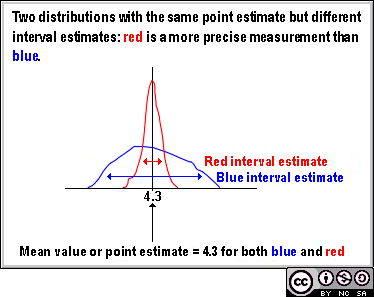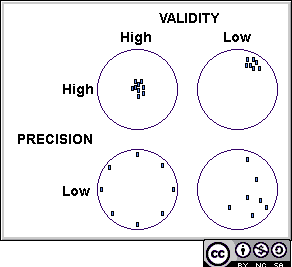
 |
| EPI8-1: The Quality Of Measurements: Precision Or Random Variation And Bias Or Systematic Variation |
OBJECTIVES |
At the end of this session you should:
|

The quality of measurement has two principal aspects which relate to the precision of the measurement - whether there is little dispersion (precise) or much dispersion (less precise) of measurements about the measure of central tendency (mean, median). In epidemiology this is termed the interval estimate of a measure.the validity of the measurement - whether the summary measure or measure of central tendency (in epidemiology the term point estimate is used), is near the true value that one is trying to measure or estimate.
Here validity is defined as the extent to which a measurement measures what it intends to measure and not something else. The concept of validity reflects how "true" the measurement is. The Target diagram illustrates the distinct concepts of precision and validity. The centre or bullseye is the "truth". Although one can get good validity with both high and low precision, low validity may be either precisely measured or with poor precision.

There is quite a bit of confusion about the meaning of Precision, Reliability, Repeatability and Reproducibility in the text books.
The main thing one is trying to measure is random variability i.e. that part of the variability that is due to chance as opposed to sources of variability that are systematic or due to bias.
The preferred term in modern epidemiology for the extent to which similar information is elicited when the measurement is repeated is precision. When it comes to the other three "R"s they mean slightly different things. Broadly Reliability and Repeatability refer to multiple measurements taken within a narrow time period being not too widely dispersed, while reproducibility refers to another set of similar measurements being done somewhere else by someone else at a different point in time.
Validity or lack of bias on the other hand means the extent to which your measurement actually measures what it is intended to measure (the "truth"). This term too is used quite loosely in the textbooks and literature and has several meanings when it is typically used.
